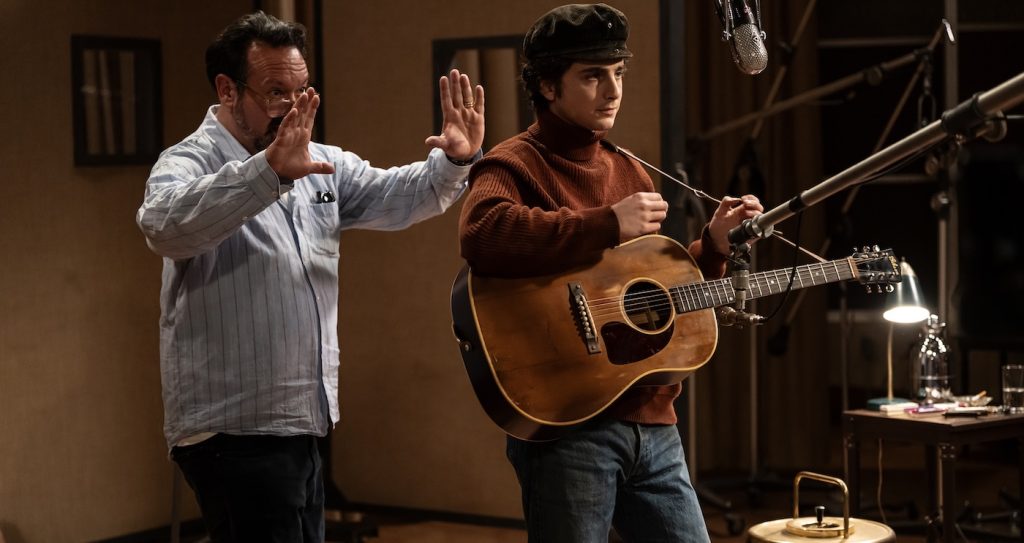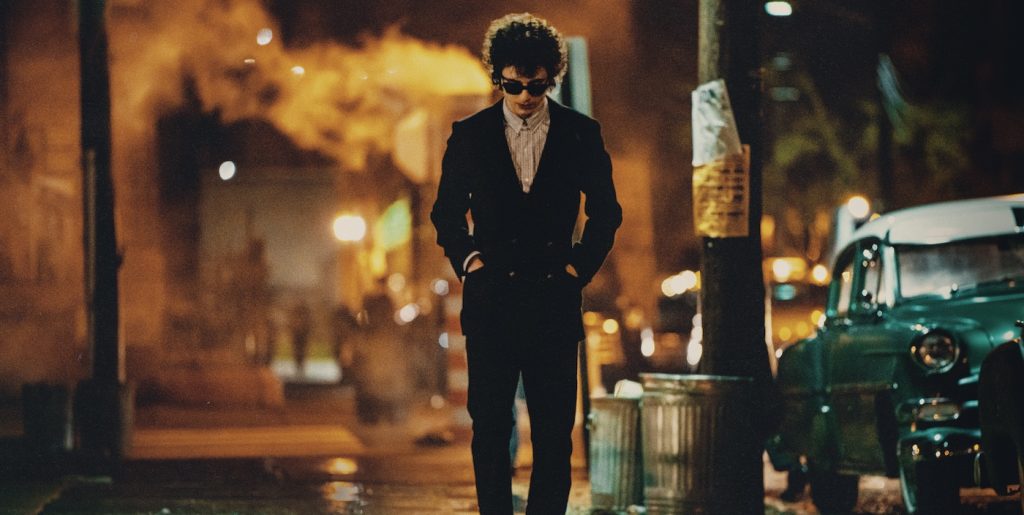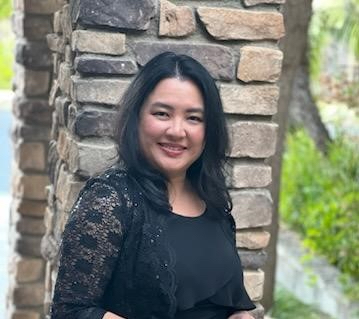“A Complete Unknown”: Orchestrating 60+ Live Performances for Oscar-Worthy Sound
In one of this year’s tour de force performances, Timothée Chalamet’s Oscar-nominated portrayal of one of America’s greatest singer-songwriters took almost six years to perfect (partly thanks to COVD-19 delays in production). For director James Mangold’s music biopic, A Complete Unknown, Chalamet not only learned to play the guitar and harmonica for the film, but also mastered Dylan’s famously idiosyncratic style to deliver over 40 flawless live-to-camera performances as the narrative charts his meteoric rise after arriving in New York in 1961.
As Oscar-nominated sound mixer Tod A. Maitland reveals, “Working on this film is like recording a double album and a really complex film sound at the same time.” He joins four other members of the sound team who are also nominated for their splendid work: supervising sound editor Donald Sylvester, supervising music editor Ted Caplan, and re-recording mixers Paul Massey and David Giammarco.
We recently talked to the team about the Herculean feat of pulling off such an ambitious project and why they had to hide a microphone in Chalamet’s hair for some of the sequences.
How big is the sound team on a project like this?
Maitland: On the production side, it’s myself, the boom operator [Jerry Yuen], sound utility [Terence C. McCormack Maitland], and the Pro Tools operator. And also the executive music producer [Nick Baxter] and music supervisor [Steven Gizicki].
Sylvester: The rest of us are in post. I had three dialog editors [Russell Farmarco, Anna MacKenzie, and Robert Troy].
Giammarco: I had two sound effects editors [Eric A. Norris and Jon Title] and a legion of Foley editors/mixers and Foley Walkers who walked the show and performed the Foley. They do footsteps, hand claps, bang into walls, and all kinds of practical sound actions for what we see on the screen.
Sylvester: It’s also called sync to picture effects.
Giammarco: This movie was quite different because we needed a full soundtrack of sound effects for international versions, and Foley played a big part in that.
Sylvester: When we translate the film and have other actors re-voice, we remove Tod’s [production] track, so we have to replace them with identical sounds. “Fully-filled” means that anything we take away, we put back.
Caplan: I had an assistant music editor [Maggie Talibart] and also worked with Steven, Nick, and his music engineer. Nick was on this movie before we ever got into production. He did pre-record with everybody and found the songs with Timmy and Monica [Barbaro, who played singer-songwriter Joan Baez]. He was on set walking them through the performances, which was crucial.
This film is very unique with over 60 live-to-camera music performances. So, there isn’t as much separation between production sound and mixing/editing, right?
Caplan: Yes and no. Tod miked the performances so discreetly, and it’s not one mic capturing the whole thing. You’ve got vocal mics, guitar mics, band mics, separate mics for everybody, and the crowd mics, so there’s a lot of separation even though it’s all done at once. That immensely helped us have a lot more control in post so that we weren’t saddled with one track of comp performances.
Did you have to use playback while shooting any of the singing sequences?
Maitland: I’ve done 16 music-based films and never one that didn’t have playback, ear wigs, or timing mechanisms. This film was done entirely live—if you didn’t record it [during filming], it didn’t make it onto the film. For all the performance pieces, we had 42 period-accurate microphones. We also wanted a tapestry of sounds so that each venue had a different sound to it. I watched Timmy in rehearsals and realized he held the guitar the same way Bob did, which was very high up on his body. So, for scenes where he wasn’t performing at a venue, there was really no other way to mic him other than putting the microphone in his hair and inside the guitar and using ambient mics around that. It took some convincing to get Timmy and the hair department on board, but it worked out brilliantly!
Did you only have to put the mic in his hair for scenes that didn’t involve a concert or a music festival?
Maitland: When he was in the hospital room, cabin, apartment, or inside the Gaslight [Café], he didn’t have a mic in front of him. Those were incredibly challenging scenes to record. If the camera is far away, you need to have a microphone close enough to capture his voice and the guitar, but there was no way to put one on his body since the guitar would cover it. So going into his hair was the only way. And it worked out brilliantly because the microphone is on his forehead aiming down right past his mouth and towards the guitar.
Wow, that’s very cool! How was the sound quality from the vintage microphones?
Maitland: They were great! Microphones back then have a very different, mid-range sound. They didn’t have the fullness that microphones have now. So, they captured the sound of that period incredibly well.

How did you create the soundscape of 1961-1965’s Greenwich Village in New York when Bob and Sylvie (Elle Fanning) were walking in the streets? It really feels like we’ve been dropped into Lower Manhattan during that era.
Caplan: We wanted contrast in those scenes. When Bob arrives on MacDougal Street at the beginning of the movie, it feels inspiring and alive. We had nine tracks playing overlapping, coming out of cars or stores and street hucksters. One of the pieces we used was by Moondog, a real street performer from that time who played on MacDougal Street. It was really fun to find a voice for the street musically that blended with all the stuff that Dave and Don did to bring it to life.
Massey: Jim wanted it to be alive and boisterous, with different sounds and music coming at Bob from all directions and spaces as he walked across the street. Each new sound attracted his attention and was mixed to show movement as he passed by—distant perspectives becoming close and then distant again, all from different sources and directions. Conversations, acoustic guitars, preaching, club music—it was an exciting and vibrant New York soundscape.

What about recreating the ambient sounds of the city for two very different periods?
Caplan: When he walks in [in 1961], there’s tambourines, acoustic guitars, soul music, blues music, so many styles that gave you this excitement about him arriving to a place that was alive and full of music. Then, in 1965, when we come back to MacDougal Street, it was a lot more aggressive. What was inviting seems a little more oppressive to him. You have Peter, Paul and Mary playing, the music out of clubs, and the opera music. It’s still an eclectic sound, but now, it feels oppressive because the world has become more stressful for him.
Massey: By 1965, Bob had become more confident, and the street was teaming with creativity. So, we wanted to have different music elements highlighted as he made his way down the street. Again, acoustic panning and using distant-to-close-up perspectives on people singing, sound effects, and music as he passed by. Several of the pass-bys had to be quick and at the moment to give way for the next event. Others could overlap, lingering in the distance from a block away.
Check back tomorrow for the conclusion of our chat to find out what it took to accomplish the climactic sequence that recreates the famed 1965 Newport Folk Festival.
For more on A Complete Unknown, check out these stories:
“A Complete Unknown” Costume Designer Arianne Phillips on Channeling the Bob Dylan Mystique
Featured image: Timothée Chalamet in A COMPLETE UNKNOWN. Photo by Macall Polay, Courtesy of Searchlight Pictures. © 2024 Searchlight Pictures All Rights Reserved.



